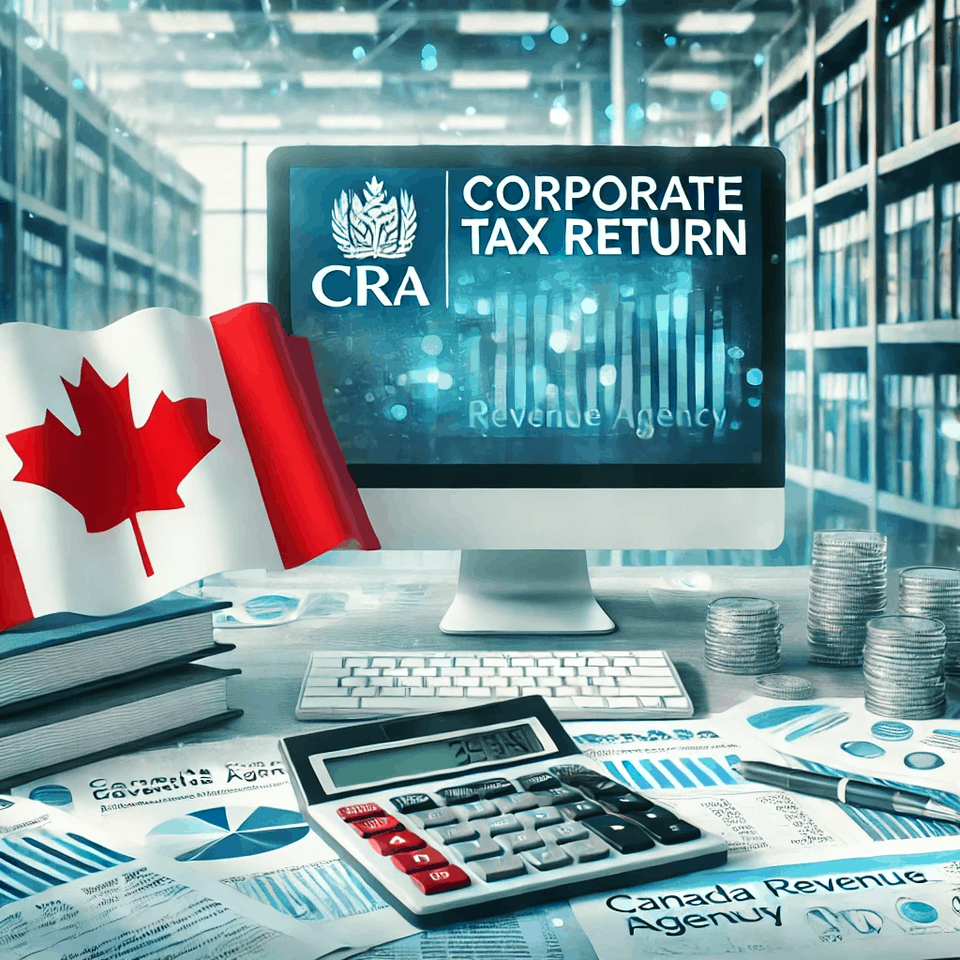Introduction
Filing corporate tax returns in Canada is a critical responsibility for businesses, ensuring compliance with federal and provincial tax regulations. This guide provides a comprehensive overview of the corporate tax return process in Canada, helping you navigate the complexities of tax filing and avoid potential pitfalls.
Understanding Corporate Tax in Canada
In Canada, corporations are required to file an annual corporate income tax return. The corporate tax system is governed by the Canada Revenue Agency (CRA) at the federal level, while each province or territory imposes additional corporate taxes. The tax return must be filed within six months of the end of the corporation’s fiscal year.
Federal Corporate Tax
The federal corporate tax rate in Canada is 15%. However, small businesses that qualify for the Small Business Deduction (SBD) are eligible for a reduced tax rate of 9% on their first $500,000 of active business income. This deduction is aimed at supporting the growth and sustainability of small enterprises.
Provincial and Territorial Taxes
In addition to federal taxes, corporations in Canada are subject to provincial or territorial taxes, which vary depending on the region. These taxes range from 8% to 16% and are applied after the federal tax is calculated. Some provinces offer additional deductions and credits to reduce the overall tax burden on businesses.
Filing a Corporate Tax Return
Filing a corporate tax return in Canada involves several key steps:
- Gather Financial Information: Collect all necessary financial documents, including income statements, balance sheets, and records of expenses. Accurate record-keeping is crucial for ensuring that all taxable income and allowable deductions are correctly reported.
- Determine Taxable Income: Calculate the corporation’s taxable income by subtracting allowable deductions from total revenue. Deductions may include operating expenses, capital cost allowances, and other business-related costs.
- Complete the T2 Form: The T2 Corporate Income Tax Return is the standard form used for filing corporate taxes in Canada. This form requires detailed information about the corporation’s income, expenses, and tax credits.
- Claim Tax Credits and Deductions: Ensure that all applicable tax credits and deductions are claimed to reduce the overall tax liability. Common credits include the Scientific Research and Experimental Development (SR&ED) credit, which supports innovation, and the Investment Tax Credit (ITC) for capital investments.
- File the Return: Submit the completed T2 form and any supporting documents to the CRA. The return can be filed electronically through the CRA’s online services or by mail. It’s important to meet the filing deadline to avoid penalties and interest on unpaid taxes.
Key Deductions and Credits
Corporations in Canada can benefit from a variety of deductions and tax credits that help lower their taxable income:
- Capital Cost Allowance (CCA): This deduction allows corporations to write off the cost of depreciable assets, such as machinery, vehicles, and buildings, over time.
- Scientific Research and Experimental Development (SR&ED) Credit: Businesses that engage in research and development can claim this credit, which provides a significant reduction in tax payable.
- Investment Tax Credit (ITC): This credit applies to certain investments in qualified property, such as machinery and equipment used in manufacturing or processing.
- Small Business Deduction (SBD): As mentioned earlier, small businesses can benefit from a lower tax rate on their first $500,000 of active business income.
- Loss Carryovers: Corporations that incur a net loss in a given year can carry the loss back up to three years or forward up to 20 years to offset taxable income in those years.
Important Deadlines and Penalties
Meeting deadlines is crucial when filing corporate tax returns in Canada. The standard deadline is six months after the end of the corporation’s fiscal year. For example, if the fiscal year ends on December 31, the tax return is due by June 30 of the following year.
Failure to file on time can result in penalties, which are generally 5% of the unpaid tax, plus 1% of the unpaid tax for each month the return is late, up to a maximum of 12 months. If the corporation repeatedly fails to file, the penalties can increase significantly.
Record Keeping and Audits
Maintaining accurate records is essential for filing a correct tax return and for potential audits by the CRA. Corporations are required to keep records of all income, expenses, and deductions for at least six years. The CRA may audit a corporation’s tax return to ensure compliance, so having thorough documentation is critical.
How to Maximize Tax Efficiency
To maximize tax efficiency, corporations should consider the following strategies:
- Tax Planning: Engage in year-round tax planning to identify opportunities for deductions, credits, and deferrals. This proactive approach can help reduce the overall tax burden.
- Incorporating a Holding Company: Some corporations may benefit from incorporating a holding company to manage investments and protect assets. This can also provide tax deferral opportunities.
- Income Splitting: Distributing income among family members who are in lower tax brackets can reduce the overall tax liability. However, it’s important to comply with the CRA’s rules on income splitting.
- Charitable Donations: Corporations can receive a tax credit for donations made to registered charities. This not only supports community initiatives but also reduces the corporate tax burden.
The Role of a Tax Professional
Navigating the complexities of corporate tax filing in Canada can be challenging, especially for businesses with intricate financial situations. Engaging a tax professional can provide valuable guidance and ensure that the corporation is taking full advantage of available deductions and credits.
A tax professional can also assist with:
- Tax Planning: Developing a comprehensive tax strategy that aligns with the corporation’s financial goals.
- Filing Assistance: Ensuring that all necessary forms and documentation are correctly completed and submitted on time.
- CRA Audits: Representing the corporation during an audit and helping to resolve any issues that arise.
Common Mistakes to Avoid
Corporations should be aware of common mistakes that can lead to penalties or increased tax liability:
- Missing Deadlines: Failing to file on time can result in significant penalties and interest charges.
- Incorrect Information: Errors in the tax return, such as incorrect income reporting or miscalculating deductions, can lead to audits and reassessments.
- Overlooking Deductions and Credits: Not taking full advantage of available deductions and credits can result in a higher tax bill.
- Poor Record-Keeping: Inadequate documentation can lead to issues during a CRA audit and may result in denied deductions.
Conclusion
Filing a corporate tax return in Canada is a complex but essential process for businesses of all sizes. By understanding the requirements, deadlines, and available deductions, corporations can effectively manage their tax obligations and optimize their financial position. Engaging a tax professional can provide additional peace of mind, ensuring that the corporation remains compliant with all tax regulations and takes full advantage of opportunities to reduce its tax burden.











Leave a Reply